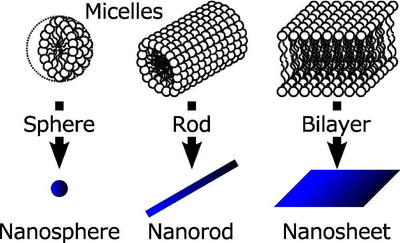Soft-template Method for Materials Synthesis
Size and shape are closely related to the properties of materials as well as their chemical compositions. Nanomaterials like nanospheres, nanorods and nanosheets, and porous materials like nanoporous, mesoporous, and macroporous materials have a high-specific surface area in some cases and have shape anisotropy in other cases, which induce properties different from those of their bulk states.
Bottom-up methods by using some templates to construct such ordered-structures have recently attracted a great deal of attention. The methods are divided into two categories; hard-template methods use solids like particles and zeolite as the templates, and soft-template methods use soft matter like micelles, emulsions, liposomes, polymer blends, and liquid crystals as the templates1).
In the latter case, micelles and bilayers give nanoparticles and nanosheets, respectively, as shown in Figure. Especially, lamellar phases with concentrated bilayers give aggregated nanosheets. To apply the resulted nanosheets, dispersion is needed. We have recently reported that we can obtain dilute solutions of nanosheets with 1 nm thickness using hyperswollen lamellar phases as the template 2) .
We can obtain monolithic ordered porous materials using the continuous phases of micelles and emulsions1,3). We have recently reported three dimensional porous polymer materials with pore diameters larger than 100 μm using mono-dispersed emulsions4) .
Soft-template methods are one of the most promising methods to synthesis various fine-structured materials.
1) S. Tanaka et al., Chap 1, Section 12 in "Nanospace Materials Handbook," Ed. K. Ariga, (NTS, 2016.2).
2) Y. Uchida et al., J. Am. Chem. Soc., 2016, 138, 1103.
3) H. Yabu et al., Langmuir 2005, 21, 1709.
4) Y. Iwai et al., Macromol. Rapid Commun., in press. DOI: 10.1002/marc.201600502.
Yoshiaki Uchida, Graduate School of Engineering Science, Osaka University
